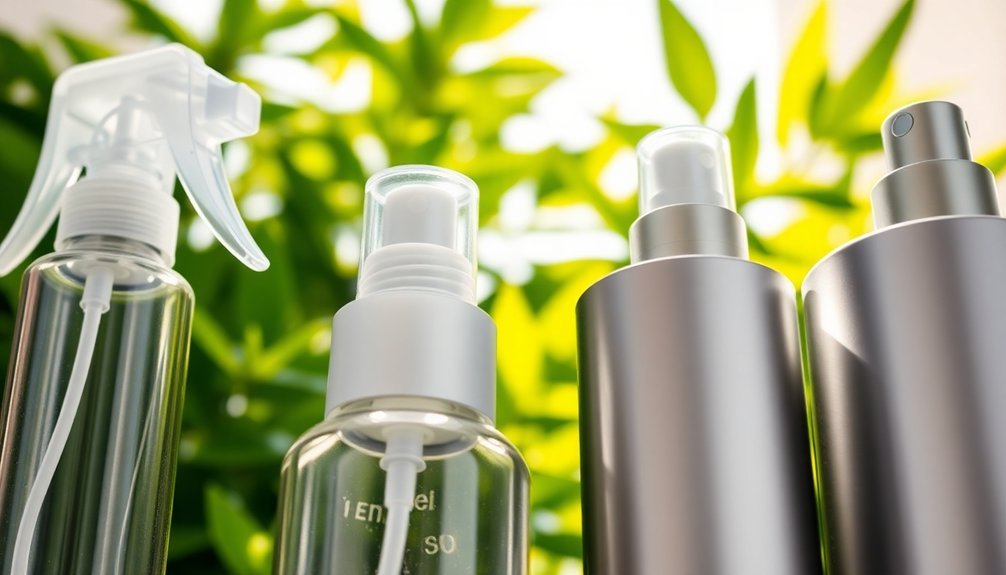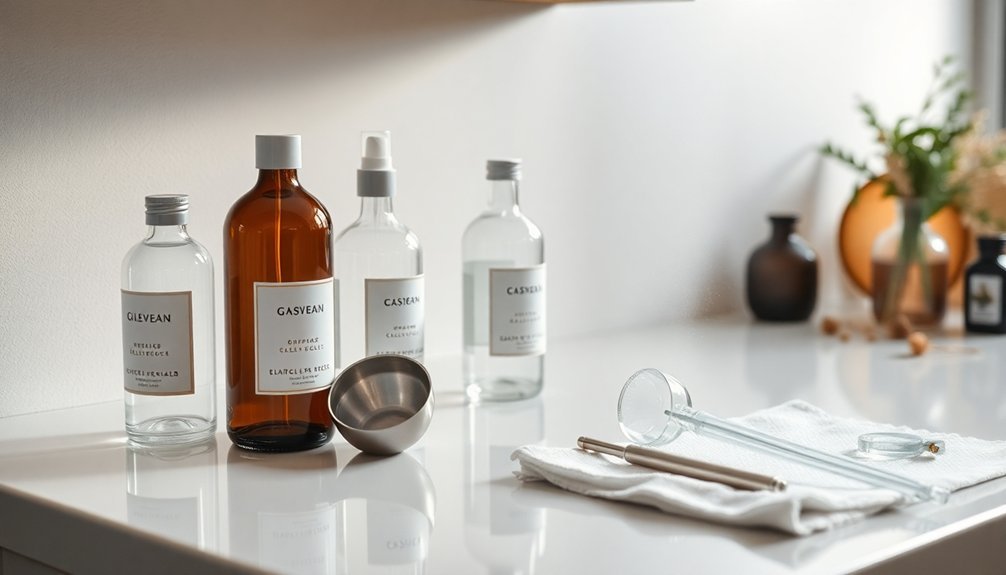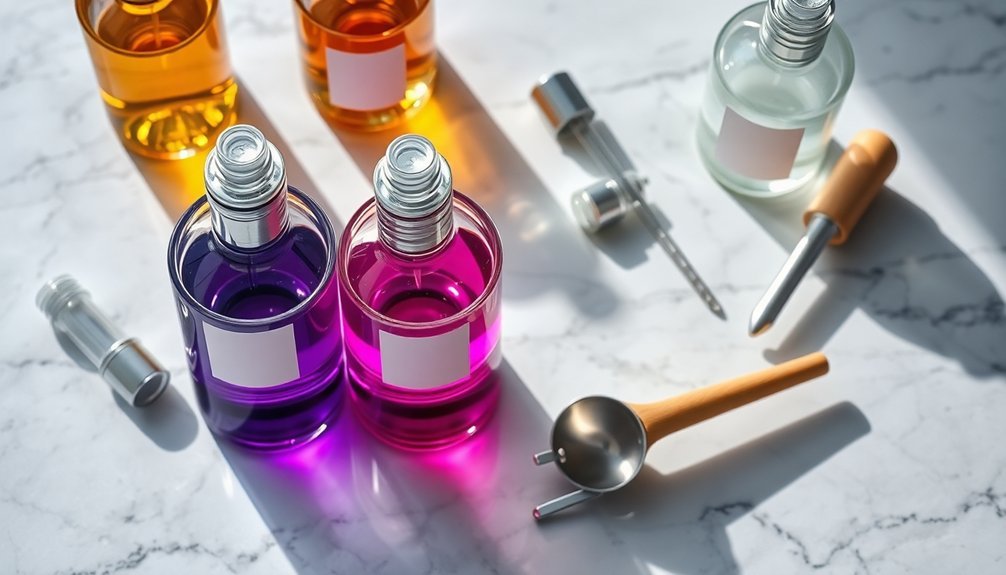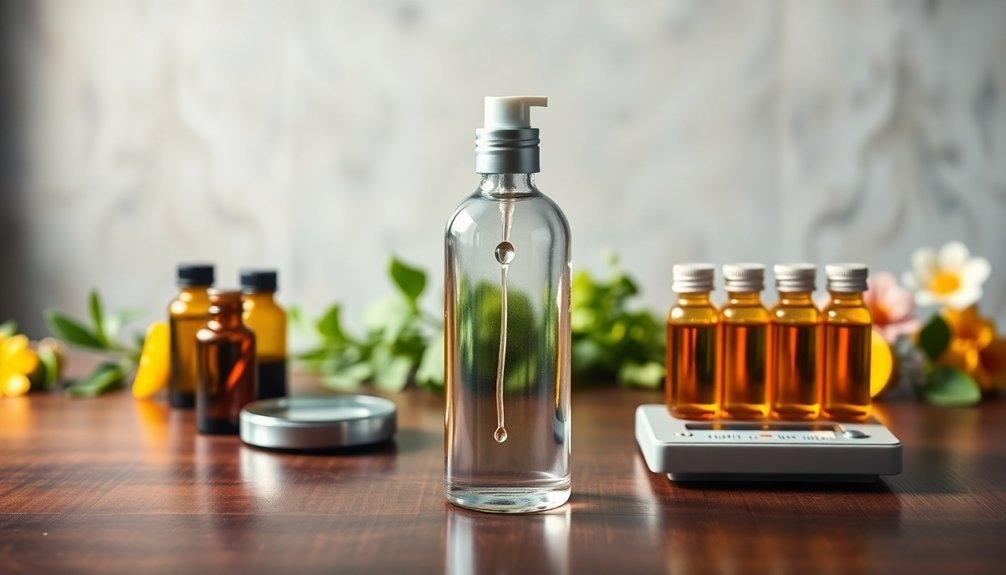To set up a professional spray bottle system for fragrances, you'll need glass or high-grade plastic bottles, precise measuring tools like pipettes and digital scales, and appropriate safety gear including gloves and goggles. Start by sanitizing all components in hot water (180°F), then properly measure and mix your ingredients using glass stirring rods. Choose a quality spray mechanism that matches your fragrance's consistency. Following these essential steps will open your path to creating lasting, quality fragrances.
Selecting the Right Spray Bottle Materials

Three critical factors guide your spray bottle material selection: durability, chemical compatibility, and cost-effectiveness.
Glass stands out as your most reliable choice, offering superior resistance to chemical degradation and maintaining fragrance integrity over time. You'll find it's particularly well-suited for long-term storage and premium presentations. The addition of calcium carbonate compounds to glass manufacturing enhances the bottle's durability and heat resistance.
Glass delivers unmatched chemical stability and fragrance preservation, making it the premier choice for high-end perfume presentations and extended storage.
If you're creating travel-sized fragrances or need shatter-resistant options, consider plastic bottles. They're lighter and more affordable for mass production, though they may not offer the same level of chemical stability as glass.
For luxury projects, crystal provides an upscale appearance but comes with higher production costs.
Whatever material you choose, verify it's compatible with your fragrance formulation to prevent unwanted chemical reactions that could compromise your final product.
Essential Tools and Supplies Checklist
You'll need fundamental equipment like glass beakers, stirring rods, and digital scales to start your spray bottle setup.
Your measuring arsenal should include precise tools such as pipettes, droppers, and graduated cylinders to guarantee accurate ingredient portions.
While these basics will get you started, consider adding advanced items like thermometers and lab-quality filter paper as you expand your fragrance-making capabilities. For safety during mixing, always wear appropriate protective gloves when handling fragrance materials.
Basic Equipment Needs
Setting up a spray bottle workspace requires several essential tools and safety equipment to secure proper handling of fragrances and chemicals.
You'll need glass bottles with secure caps and closures to store your fragrances safely. Don't forget protective gear like gloves, safety goggles, and a lab coat to shield yourself from spills.
A stable worktable, funnels, and eye-droppers will help you measure and transfer liquids precisely. Common solvents like ethanol and isopropyl are necessary for diluting your fragrance oils. Keep your workspace organized with shelves and drawer organizers for easy access to supplies.
Proper ventilation is vital, so make sure your area has adequate airflow. Stock up on cleaning supplies and sterilization tools to maintain hygiene.
Remember to label your bottles clearly and keep safety data sheets in organized files. A fire extinguisher should always be within reach for emergencies.
Advanced Measuring Tools
Professional fragrance creation demands precise measurement tools that go beyond basic equipment.
You'll need a high-accuracy scale for weighing ingredients and precision pipettes for transferring small volumes of essential oils. Advanced measurement systems can analyze multiple parameters like density, refractive index, and color in a single cycle.
For enhanced precision and quality control, you'll want to invest in:
- A multi-parameter measurement system that combines density, refractive index, and optical rotation analysis
- Digital data management software to track and store your fragrance formulations
- High-precision graduated cylinders and glass beakers for accurate volume measurements
These tools will help you maintain consistency in your fragrance creation process while ensuring professional-grade results in your final products.
Proper Cleaning and Sterilization Methods

Before starting any sterilization process, you'll need to put on protective gloves and work in a well-ventilated area to guarantee your safety.
You can sanitize your spray bottle effectively by submerging it in boiling water for 10 minutes, making sure all parts are completely covered.
If you're using chemical disinfectants, carefully follow the product's dilution ratios and contact time requirements while keeping the solution away from your skin and eyes.
Sterilization Safety Protocols First
To guarantee your spray bottle remains safe for repeated use, proper sterilization must be your top priority.
You'll need to carefully disassemble the bottle and prepare the necessary safety equipment, including gloves and tongs, before beginning the sterilization process.
- Pre-clean all components with mild dish soap and high-pressure water to remove visible debris, ensuring you've reached all the intricate parts.
- Choose your sterilization method – steam sterilization offers the most effective results, while boiling provides a reliable alternative if you don't have specialized equipment.
- Allow parts to air dry completely on a clean towel in direct sunlight, which provides additional UV sterilization benefits.
Remember to regularly descale your steam sterilizer if you're using one, as this maintains its effectiveness for future use.
Hot Water Sanitizing Steps
Building on our sterilization protocols, hot water sanitizing offers a reliable method for maintaining your spray bottle's cleanliness.
You'll need to heat water to at least 180°F (82°C) and guarantee your bottle is free from visible debris before starting.
First, fill a container with enough hot water to completely submerge your spray bottle components.
Carefully place all parts in the water and maintain the temperature for a full 5-minute soak.
Keep track of the time to guarantee proper sanitization.
Once complete, let the parts cool naturally and dry them thoroughly.
Store your sanitized bottle components in a clean, dry place until you're ready to use them.
Remember to handle the sanitized pieces carefully to prevent recontamination and check regularly for any signs of wear.
Chemical Disinfection Guidelines
While hot water sanitizing provides one effective method, chemical disinfection requires careful attention to both safety and effectiveness.
You'll need to store disinfectants in their original containers and properly label any diluted solutions in spray bottles. Always read product labels and safety data sheets before use, and verify the disinfectant is compatible with your surfaces.
- Spray the disinfectant onto a cloth rather than directly on surfaces to prevent pathogen spread, and verify surfaces remain wet for the recommended contact time.
- Test solution concentrations regularly with test strips and replace when they become weak or cloudy.
- Operate within manufacturer-specified temperature ranges (typically 55°F-120°F) and avoid spraying when others are nearby to prevent inhalation risks.
Measuring and Mixing Components

Creating the perfect spray bottle fragrance starts with precise measurements and systematic mixing. You'll need a digital scale for accurate ingredient weighing and pipettes to measure your essential oils precisely. Keep a notebook handy to record your recipes and observations.
Precise measurements and proper tools are essential for crafting quality fragrances. A digital scale, pipettes and detailed notes ensure consistent results.
Begin by adding your base notes, which form your fragrance's foundation. Follow with middle notes to add depth, then finish with top notes for initial impact. You'll want to use glass stir sticks to blend thoroughly.
As you mix, use scent strips to evaluate your creation objectively. Watch your proportions carefully as you balance the different notes. If you're adding water, use only distilled water to maintain clarity.
Consider adding a few drops of glycerine to help preserve your fragrance's strength and longevity.
Understanding Spray Mechanism Types
Now that you've prepared your fragrance mixture, selecting the right spray mechanism will determine how effectively it's delivered.
Each type offers distinct advantages, from the popular pump sprayers that create fine mists to pressure sprays that provide fast, controlled application.
The spray mechanism's nozzle design plays an essential role in how your fragrance performs, affecting droplet size and distribution patterns.
You'll want to take into account these key factors when choosing your sprayer:
- Pump sprayers – Ideal for everyday use, offering consistent fragrance distribution and easy operation
- Pressure sprays – Perfect when you need quick, uniform coverage and precise control
- Atomizers – Best for ultra-fine mist application and gentle fragrance delivery, particularly suitable for delicate formulations
These mechanisms can greatly impact your fragrance's performance and user experience.
Storage and Preservation Guidelines

Proper storage and preservation of your fragrance mixtures can greatly extend their lifespan and maintain their intended scent profiles.
Smart storage practices help protect your precious fragrance formulations and keep them smelling exactly as designed.
You'll want to store your bottles in a cool, dark environment away from direct sunlight and heat sources. A stable-temperature closet or drawer is ideal.
Always keep your bottles tightly sealed to minimize oxygen exposure, which can cause oxidation and alter the scent.
Don't repackage your fragrances unless necessary, as original bottles provide maximum protection. If you need to decant, use smaller containers to reduce air contact.
For particularly delicate scents, refrigeration might help preserve freshness.
Handle your bottles gently and avoid shaking them vigorously.
When working with fragrances, use proper tools like funnels and pipettes to prevent contamination and minimize spills.
Safety Precautions for Bottle Handling
When handling concentrated fragrances and essential oils, your safety should be your top priority.
You'll need to wear chemical-resistant gloves and protective goggles to prevent skin contact and eye exposure.
Don't forget to work in a well-ventilated area and use a half-mask respirator with organic vapor filters when working with concentrated substances.
- Keep your workspace free from ignition sources and electrical appliances that could pose fire hazards.
- Have an emergency response plan ready, including quick access to first aid supplies and emergency shower facilities.
- Always check fragrance compatibility with your spray bottle materials and maintain strict hygiene practices.
Remember to wash your hands thoroughly after handling fragrances and follow established safety protocols to prevent accidents and cross-contamination.
Quality Testing Your Spray Setup

Before releasing your fragrance creation, thorough quality testing guarantees your spray setup delivers consistent, reliable results.
Start by testing your spray mechanism with blotter strips to evaluate the initial dispersion pattern and droplet size. You'll want to observe how your fragrance performs in different environments, paying attention to both projection and longevity.
Test your spray bottle's performance across various humidity levels and room sizes to verify it maintains ideal dispersion. Document your findings, noting any inconsistencies in spray patterns or scent delivery.
Don't forget to compare your setup against commercial products to benchmark its performance. Make adjustments to your spray mechanism or fragrance concentration if needed, and repeat testing until you achieve the desired results.
Consider gathering feedback from multiple users to validate your setup's effectiveness.
Frequently Asked Questions
How Long Can Fragrance Oils Remain Stable in Different Bottle Materials?
Your fragrance oils will stay stable longest in dark glass (3-5 years), moderate in HDPE plastic (1-2 years), and shortest in clear containers or metal. Always store them properly to maximize stability.
Can Temperature Changes Affect Spray Bottle Performance During International Shipping?
Yes, you'll notice temperature changes greatly affect spray bottles during shipping. They can cause expansion, contraction, and seal issues, while also impacting the liquid's viscosity and spray performance through the nozzle.
Which Bottle Sizes Work Best for Testing Versus Final Production?
You'll want 10ml bottles for testing new fragrances and gathering feedback. For final production, opt for larger 32 or 64 oz containers to maximize efficiency and reduce per-unit costs in bulk manufacturing.
Does UV Exposure Through Clear Bottles Affect Fragrance Composition Over Time?
Yes, UV light through clear bottles will degrade your fragrance over time. You'll notice changes in scent and color due to photodegradation. That's why it's best to use dark or frosted bottles instead.
How Often Should Spray Mechanisms Be Replaced in Long-Term Production?
You'll need to replace spray mechanisms every 6-12 months depending on usage volume and material quality. Monitor for clogging, reduced spray performance, or inconsistent output to determine when replacement's necessary.





Leave a Reply